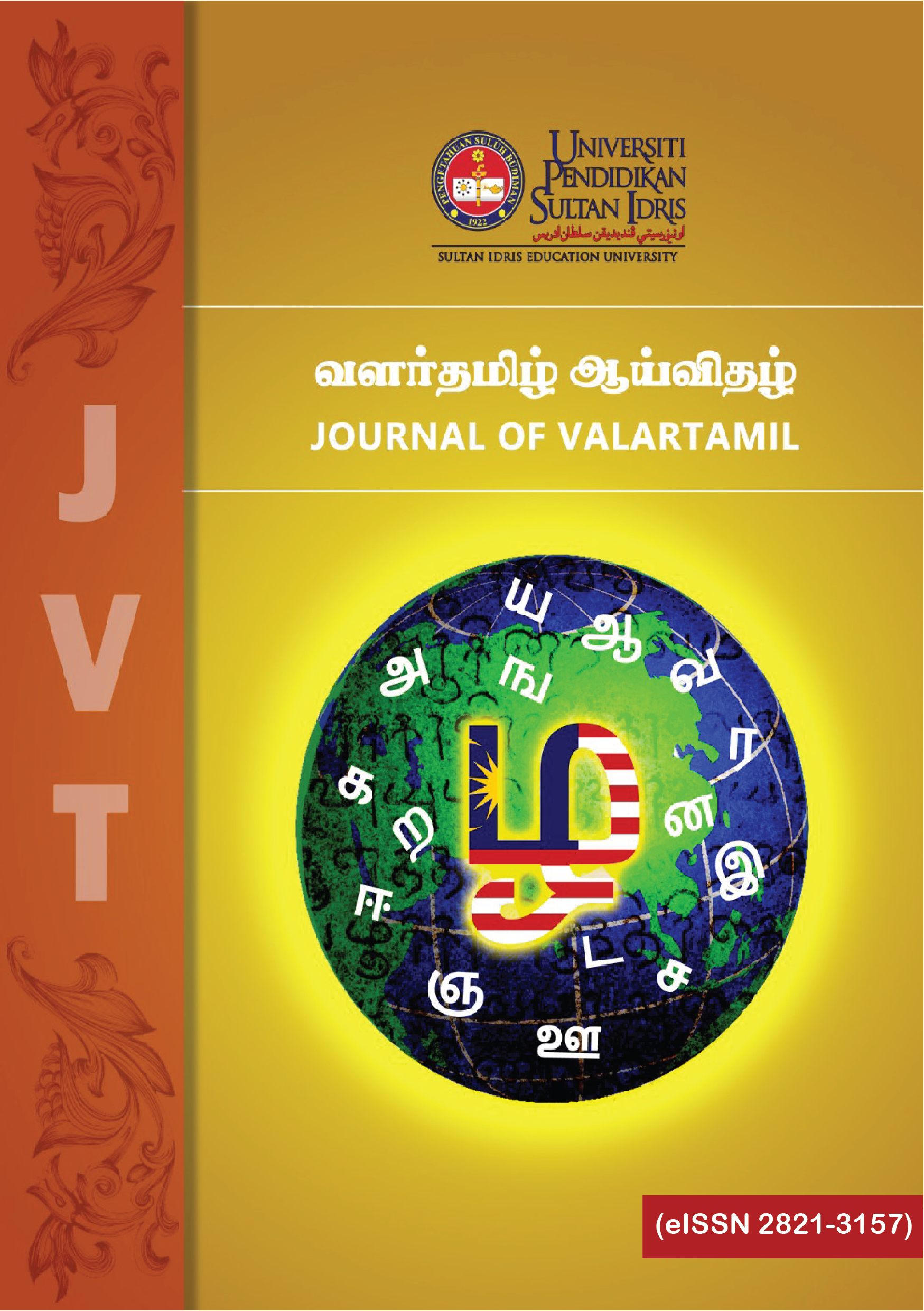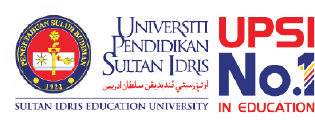கோறனிப் பெருந்தொற்று தொடர்பான முகநூல் பதிவுகளில் தொடர்பாடல் உத்திகள்
Communication Strategies in COVID-19 Pandemic Related Facebook Posts
DOI:
https://doi.org/10.37134/jvt.vol2.1.6.2021Keywords:
கோறனி, தொடர்பாடல் உத்திகள், பெருந்தொற்று, முகநூல் பதிவுகள், விளைபயன்மிக்க தொடர்பாடல்Abstract
சமூக வலைத்தளங்களில், மக்கள் எளிமையாகவும் விரைவாகவும் தகவல்களைப் பெற இயலும். எனவே, நாளிதழ், வானொலி, தொலைக்காட்சி போன்ற மரபுவழி ஊடகங்களைக் காட்டிலும் சமூக வலைத்தளங்களே இன்று பெரும்பாலான மக்களின் தேர்வாக அமைந்துள்ளன. நடமாட்டக் கட்டுப்பாட்டுக் காலத்தில் முகம் பார்த்து உரையாடும் வாய்ப்புக் குறைந்ததால், கோறனிப் பெருந்தொற்றின் ஆபத்தையும், மக்கள் மேற்கொள்ள வேண்டிய தற்காப்பு நடவடிக்கைகள் தொடர்பான தகவல்களையும் வழங்குவதற்கும் மக்களைத் தொடர்புகொள்ளவும், அரசு அதிகாரிகள் பல்வேறு சமூக வலைத்தளங்களின் துணையையே நாடுகின்றனர். அவ்வகையில், இந்தக் கட்டுரை மலேசியாவில் சிறுபான்மையினராக வாழும் தமிழர்களின் சமுதாயத் தலைவர், சமூக ஊடகங்களின் துணையுடன் எத்தகைய விளைபயன்மிக்க தொடர்பாடல் உத்திகளைப் பயன்படுத்தி, இந்த இடர்காலத்தில் மக்களுக்குத் தேவையான தகவல்களை வழங்கினார் என்பதை ஆராய்ந்துள்ளது. டத்தோ ஶ்ரீ எம். சரவணனின் முகநூல் பக்கத்தில் அடையாளங்காணப்பட்ட 17 பதிவுகள், Hyland-Wood, Gardner, Leask, Ecker (2021) ஆகியோர் பரிந்துரைத்த பத்துத் தொடர்பாடல் உத்திகளின் அடிப்படையில் பகுத்தாயப்பட்டன. சரவணனின் முகநூல் பக்கத்தில், கோறனி தொடர்பான தமிழ்ப் பதிவுகள் குறைந்த எண்ணிக்கையில் இருந்தாலும் ஒவ்வொரு பதிவிலும் பல்வகை தொடர்பாடல் உத்திகள் கையாளப்பட்டிருந்தன.People obtain information easily and quickly in social media. Therefore, social media is the preferred media rather than conventional media, such as newspapers, radio, and television. As face-to-face communications are restricted during Movement Control Order (MCO), Government officials has used various social media platforms to communicate and convey messages related to pandemic risks and prevention actions to be taken. As such, this article examines how a community leader of minority Tamils in Malaysia, used social media, with effective communication strategies to provide needed information during the crisis. Based on the Hyland-Wood et al. (2021) communication strategies, 17 posts identified in Datuk Seri M. Saravanan's Facebook page were analysed. Despite the small number of Tamil posts related to the COVID-19 pandemic on Saravanan's Facebook page, findings show various communication strategies were employed in each post.
Keywords: COVID-19, communication strategies, effective communication, Facebook posts, pandemic
Downloads
References
Aruma, E. O. (2018). Roles of communication in community development. International Journal of Network and Communication Research, 5(1), 1-10.
Azlan, A. A., Hamzah, M. R., Sern, T. J., Ayub, S. H., & Mohamad, E. (2020). Public knowledge, attitudes and practices towards COVID-19: A cross-sectional study in Malaysia. Plos one, 15(5), e0233668.
Cammett M., & Lieberman, E. (2020). Building solidarity: Challenges, options, and implications for COVID-19 responses. COVID-19 Rapid Response Impact Initiative. White Paper 4, Issued on March 30, Edmond J. Safra-Centre for Ethics, New York.
Elengoe, A. (2020). COVID-19 outbreak in Malaysia. Osong Public Health and Research Perspectives, 11(3), 93.
Everett, J.A.C., Colombatto, C., Chituc, V., Brady, W.J., & Crockett, M. (2020). The effectiveness of moral messages on public health behavioral intentions during the COVID-19 pandemic. https://doi.org/10.31234/osf.io/9yqs8
Franz, D., Marsh, H. E., Chen, J. I., & Teo, A. R. (2019). Using Facebook for qualitative research: a brief primer. Journal of medical Internet research, 21(8), e13544.
Hyland-Wood, B., Gardner, J., Leask, J., & Ecker, U. K. (2021). Toward effective government communication strategies in the era of COVID-19. Humanities and Social Sciences Communications, 8(1), 1-11.
Leask J., & Hooker, C. (2020) How risk communication could have reduced controversy about school closures in Australia during the COVID-19 pandemic. Public Health Res Practice 30(2) https://doi.org/10.17061/phrp3022007
Mishra, C., & Rath, N. (2020). Social solidarity during a pandemic: Through and beyond Durkheimian Lens. Social Sciences & Humanities Open, 2(1), 100079.
Moses, P. (2015). மட்டக்களப்பு மாவட்டத்தின் அரசியல் சமூக தொடர்பாடலில் வெகுஜன ஊடகங்களின் அபிவிருத்தி: ஓர் சமூகவியல் நோக்கு. In Emerging Trends and Challenges in Multidisciplinary Research (5th international Symposium of the South Eastern University of Sri Lanka), SEUSL, Sri Lanka, 2015 pp. 278-285. http://ir.lib.seu.ac.lk/bitstream/handle/123456789/1291/35.pdf?sequence=3
Petersen MB (2020, March 9) The unpleasant truth is the best protection against the coronavirus. Politiken.https://pure.au.dk/portal/files/181464339/The_unpleasant_truth_is_the_best_protection_against_coronavirus_Michael_Bang_Petersen.pdf
Pfattheicher.S., Nockur, L., Böhm, R., Sassenrath, C., Petersen, M.B. (2020). The emotional path to action: empathy promotes physical distancing and wearing face masks during the COVID-19 pandemic. Preprint at PsyArXiv. https://doi.org/10.31234/osf.io/y2cg5
Reynolds, B., & Quinn, S. C. (2008) Effective communication during an influenza pandemic: the value of using a crisis and emergency risk communication framework. Health Promot Practice 9(4_suppl):13S–17S. https://doi.org/10.1177/1524839908325267
Rudd, R., & Baur, C. (2020). Health literacy and early insights during a pandemic. Journal of Communication in Healthcare: Strategies, Media and Engagement in Global Health. 13(1), 13 – 16.
Sandman P, & Lanard J (2020) COVID-19: The CIDRAP Viewpoint (Center for Infectious Disease Research and Policy) [Research]. University of Minnesota. https://www.cidrap.umn.edu/sites/default/files/public/downloads/cidrap-covid19-viewpoint-part2.pdf
Stayner, T. (2020, March 26). As in-language communication about COVID-19 is harnessed to reach multicultural groups, advocates warn minority communities must not be forgotten. SBS News. https://www.sbs.com.au/news/australia-s-minority-communities-urgently-need-covid-19-resources
Subramani, R (2013).மொழியின் தோற்றமும் தொடர்பாடலின் வளர்ச்சியும். அச்சுக்கூடம்: தொடர்பாடலுக்கான பன்னாட்டு ஆய்விதழ் (Achchukkuudam an International Research Journal of Communication) 1(1), 68-79. http://achchukkuudam.thamizhagam.net/articles/pdf/The%20evaluation%20of%20language-Achchukkuudam%20Journal%20Thamizhagam%20Media.pdf
Sultan, S., & Rapi, M. (2020). Positive Discourse Analysis of the Indonesian Government Spokesperson’s Discursive Strategies during the Covid-19 Pandemic. GEMA Online Journal of Language Studies, 20(4), Article 4. https://doi.org/10.17576/gema-2020-2004-14
Zappavigna, M. (2018). Searchable talk: Hashtags and social media meta discourse. London: Bloomsbury Publishing.





